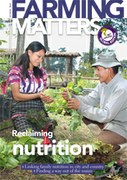Farming for nutrition: back to the future
Nutrition has become one of the buzz words of the year, like resilience, and landscapes. What they have in common is that they refer to complex situations with political forces competing over the backs of rural and urban communities. The nutrition challenge is clear – with a billion hungry people on this planet and another two billion overweight – it is time to act. Persistent hunger and undernutrition are inexcusable in a world of plenty. But the crucial question is: who should act and how?
In this issue we explore the global and local context of today’s efforts to address hunger and malnutrition. And we take a fresh look at how family farmers and consumers take the initiative in their hands, regenerating food cultures, revitalising and rejuvenating mixed farming systems, and using political spaces to call for a different, rights-based approach to food and nutrition. We see in these stories from our readers, the trend of reversing monocultures and towards multifunctional, climate resilient agroecological systems. Driven by nutrition and economic concerns, family farmers are diversifying their crops and seeking local markets which gives both rural and urban communities a better variety of food on their plates. A clear example is the experience in Kenya (page 16). Yields and on-farm biodiversity increase, as does resilience against climate shocks and price volatility, and more diversification of employment and income .
Global forces
Initiatives to combat hunger and malnutrition are not new phenomena. Decades ago there were nutrition education programmes, school feeding programmes, kitchen garden initiatives, with some of them well-integrated into agricultural and rural development and social movements. The second International Conference on Nutrition has just ended, while the first one took place 22 years ago… But today, hunger and malnutrition persist. What has changed drastically are the power dynamics underlying global efforts to address hunger, with the corporate sector gaining ever more control over essential resources such as land, water and seeds.
Diversity from field to plate
As explored in Cultivating diversity (Farming Matters 30.1, March 2014), there is a strong link between agrobiodiversity, varied diets and balanced nutrition. Though the link appears obvious between the variety of food produced, that harvested, and better nutrition, it merits further research. Several articles in this issue show inspiring examples of local champions, such as traditional chiefs in northern Ghana (page 26), and a gastronomic expert in Peru (page 30). All are part of a growing movement that promotes the use of local diversity, and connects urban and rural communities, as seen in Ecuador (page 8). Essential in this new relationship are the short distances from field to plate, which also contributes to better nutrition.
Women: drivers of change for better nutrition
It cannot be emphasised enough: women are the strongest drivers of better nutrition. It is they who most directly link production to consumption. They take most of the key decisions on what to grow or raise and how. They are responsible for cooking and processing food, for sharing it in the family, and especially for feeding the children whose adequate nutrition is crucial for their future. They decide what to take to the market and what to keep for consumption at home. They teach their children about what to eat and how to cook, and so on. A study by IFPRI found that improving women’s education explained 45% of the gains in food security, compared with increased food availability (26%) and health advances (19%). Safeguarding women’s rights, including to land and other natural resources is crucial, as is recognising the essential knowledge women hold on seeds, food preparation and nutrition. A couple of articles in this issue, one on breeding guinea pigs in Bolivia (page 20) and another on renewing home gardens in Nepal (page 12), show how women are connecting production with consumption in their homes.
Nutrition sensitive strategies
Farmers must be central in strategies to improve food and nutrition security. We need to transform food and nutrition systems, and not continue with the mistaken assumption that modern industrial agriculture can ‘feed the world’ and fix nutritional deficiencies with food fortification and genetic modification. The story of ‘Golden rice’ is a good example, a genetically engineered variety developed by industry to combat vitamin A deficiency. But it has been shown that Golden rice may pose risks to human and ecological health, and could compromise food, nutrition and financial security of rural communities. This type of single-crop approach does not address underlying causes of malnutrition and could make (hidden) malnutrition worse as it encourages rice-based diets rather than increasing access to a more diverse range of fruits and vegetables. Ample evidence, some of it in this issue of Farming Matters, shows that it is far easier and more cost effective to achieve nutritious diets with local food systems and short value chains. Accelerating progress towards the eradication of hunger is less about new technologies and more about putting what is already known into practice, and providing people with the right to their resources. Success will hinge on basing all policies, programmes and action plans on evidence and proposals from the urban and rural grassroots, and on defining them within a human rights-based framework. The millions of dollars spent by the corporate and research worlds on expensive genetically modified ’nutrition sensitive’ crops would be better spent on empowering family farmers to further develop solutions that are already available and working, such as diverse, agroecological farming practices. At the recent International Nutrition Conference, civil society rightly emphasised the point that ‘nutrition can only be addressed in the context of vibrant and flourishing local food systems that are deeply ecologically rooted, environmentally sound and culturally and socially appropriate’. As this issue of Farming Matters demonstrates, there are many ways to develop such sustainable food systems that provide long-lasting food and nutrition security. In this last issue of 20
Edith van Walsum is director of ILEIA.
Email: e.van.walsum@ileia.org

